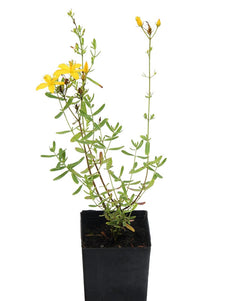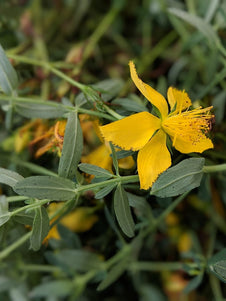







St John's Wort
St John's Wort

- In stock, ready to ship
- Inventory on the way

Usually available: All year
Life cycle: Perennial
Height: 30 - 90cm
Position: Full sun
Soil preference: Well drained
This is how we pack and send your Herb Plants to all states except TAS & WA
You will receive
- 1 St John's Wort Herb Plant in a 50 X 75mm tube - General growing instructions
All of our Herb Plants are grown organically with certified organic potting mixes and fertilizers
St John's Wort - Cannot be sent to NSW and VIC
Botanical Name: Hypericum perforatum
St John's Wort - Cannot be sent to NSW and VIC
St John's Wort is a perennial, evergreen herb growing from 30cm to 90cm high. It has a spreading habit so the width may be variable, but individual crowns may be about 30-40cm wide. The rhizomes send up stems that are erect, with a branching habit in the upper sections of the plant.
The yellow flowers appear in late spring to mid-summer, from October to January, in the second year after planting. The 2.5 cm flowers have five petals, three bundles of stamens, conspicuous black dots and are held in broad cymes at the end of branches. When the flower buds or seeds are crushed they produce a reddish purple liquid.
They yellow-green leaves have transparent dots throughout, representing the 'perforations' when viewed in bright light. There are two types of leaves each representing a different strain of St John's Wort: the broad leaf and narrow leaf strains. Similar 'broad' traits are observed in the stalks and other aspects of the plant. The leaves are stalk-less and are opposing, narrow and oblong, about 1.0-1.2cm wide for the broad leaf variety and 7-9mm wide for the narrow leaf variety.
There are approximately 370 species of Hypericum growing across the world, covering many climatic regions. More specifically, this includes the many temperate and subtropical areas of North America, Europe, Turkey, Ukraine, Russia, India, China and Brazil. Prior to being placed in the Hypericaceace family, this genus was in the gultiferacea or Clusiaceae family.
St John's Wort has many other common names throughout the world, including Tipton's Weed, rosin rose, goat weed, chase devil, or Klamath weed. The name St John's Wort may be used to refer to any species of the genus Hypericum, so it is often helpful to clarify and define the plant in question with specific characteristics. For example, in this case stating 'common' or 'perforate' St John's Wort would help to differentiate between other species.
The genus name Hypericum is derived from the Greek 'hyper' meaning 'above' and 'eikon' meaning 'picture'. The botanical and common name both refer to the traditional practice of hanging of St John's Wort over a religious icon in the house on St John's Day, to ward off evil spirits and apparitions. Some writers report that the name Hypericum simply means 'over an apparition.' The species name 'perforatum' refers to the small oil glands in the leaves which look like small perforations. They can be seen when held up to light, creating the impression of 'windows'.
Growing Conditions
St John's Wort is a complicated plant, with a complex life cycle! Aspects of this cycle are discussed below, however, once in the garden this plant looks after itself under a wide range of conditions. It is tolerant of a range of soils, but likes to grow in lighter, sandy soils. It will flower best with a sunny aspect, but can do well in part shade. The flowers appear in the second year after planting. In cold areas, plants should be established in spring after the risk of frost is over. However, St John's Wort will grow indoors or in containers when this is not possible. To propagate St John's Wort cuttings may be taken in spring or the plants may be divided in autumn after flowering.
Generally this plant thrives in winter or summer dominant rainfall patterns, and does prefer good rainfall of over 600mm per year. However, St John's Wort requires specific conditions for reproduction and can alter its growth habit to ensure survival. During times of good summer rainfall the plant will grow vegetatively. This also occurs after defoliation by insects or livestock. A single plant can increase its size by growing outward in concentric circles, sending up non-flowering stems during autumn and winter. These die off in late spring, while the flowering stems grow from the crown in spring and die off the following autumn after setting seed.
There are two sets of roots on the St John's Wort plant. One set grows vertically up to one meter into the soil and one set that grows horizontally, producing buds that form new aerial shoots. Deep rich soils favour development of the vertical roots and help the crown of the plant survive long term. In shallow soils the crown of the plant has a shorter life, but the roots grow laterally and sucker more readily creating new crowns, ensuring continued survival of the plant. The same process will occur in home gardens, however it is easy enough to control unwanted plants by hand weeding or herbicides if required. If you want to move the plant to another area, collect all the roots and dry any extra plants out completely before discarding them in the rubbish bin.
The fruit is a tiny, sticky capsule which splits open upon ripening in summer, releasing the seeds ready for the following autumn and winter. The stickiness of the seed capsule means that it can be readily transported by animals, people or machinery. They also survive the digestive tract of animals. The seeds will germinate only in very specific conditions of mild temperatures of 10-12 degrees, Celsius, in disturbed ground because they require light and when there is some rainfall to wash off a chemical inhibitor to germination. Approximately 30 000 seeds are produced by each plant and they remain viable for up to 12 years, germinating when conditions are favourable. When these conditions are mimicked by the home gardener seed germination may take from three weeks to three months.
Due to the beneficial medicinal qualities of St John's Wort, the plant is grown commercially in its native Europe. However, in some areas of the world St John's Wort has been classified as a noxious weed, due to its ability to take over livestock forage plants and disrupt natural ecology when left uncontrolled. This includes regions of Africa, Australia, North America and many other countries.
To dry St John's Wort, for personal use, collect the flowers and tops of the plant and dry them in bundles. Hang them upside down in a cool dry place indoors and then store in a sealed glass jar for up to one year.
Culinary Uses
St John's Wort is edible with the herb tops and flowers being used, but is not a culinary herb. Note, however that it is toxic for livestock when consumed. Please see below for further notes on this issue.
Medicinal Uses
St John's Wort is widely known among the medical community as a beneficial treatment for depression. In Germany it is often prescribed as a first line treatment for mild depression, especially for children and adolescents. However, it is not usually helpful for long term biological or melancholic depression. In general, studies have indicated that St John's Wort is an effective treatment for some forms of depression, often better than the placebo for serious depression. Notably, it also has significantly fewer side effects than some anti-depressant medications. In some countries, St John's Wort is available only by medical prescriptions from a pharmacy.
The active constituents in St John's Wort are hypericin and pseudohypericin, napthodiathrones, and flavonoids. Other research has explored the use of St John's Wort for the treatment of a variety of conditions, including alcoholism, ADHD, somatoform disorders and as an anti-bacterial agent for gram positive bacteria. However, there have been mixed results and more research is required to determine effectiveness and dosage levels.
Traditional herbal medicine has used St John's Wort as a topical remedy for wounds, burns, abrasions and muscle pain. Often the positive effects may be attributed to the anti-bacterial or anti-inflammatory properties of the active ingredients. An infused oil of the herb in flower results in a red oil that can be used for wounds, muscle pain and nerve pain. Other uses have included treatments for insomnia, nervous conditions, as a diuretic, to increase appetite, increase concentration, and pain management. Our dried version can be made into a herbal St John's Wort tea.
St John's Wort has also demonstrated notable antiviral properties in scientific research. Studies have shown that hypericin and pseudohypericin, two of the active compounds in the plant, can inhibit the replication of several viruses including herpes simplex virus, influenza virus, and hepatitis C virus. The mechanism appears to involve preventing viral attachment to host cells and interfering with viral protein synthesis. Some herbalists recommend St. John's Wort preparations for viral infections such as cold sores, shingles, and influenza. However, it's important to note that while laboratory studies show promise, more clinical research is needed to fully establish its effectiveness and appropriate dosing against viral infections in humans.
Naturally it is appropriate to seek medical advice before replacing or combining any current medications for treatment of depression with SJW. Since the active ingredients work to elevate serotonin, combing SJW with other anti-depressant medication could result in 'serotonin syndrome'. St John's Wort is also known to interact with a number of important medications, including but not limited to heart medication, blood thinning medication, cholesterol lowering medication and the contraceptive pill. Modification or metabolism of the chemicals in these medications may be altered by ingestion of St John's Wort, therefore reducing their effectiveness or altering the intended action.
St John's Wort is generally well tolerated. However, other general side effects of using St John's Wort may include gastrointestinal upset, dizziness, confusion, tiredness or sedation.
Livestock and Toxicity
St John's Wort is known around the world for its toxicity to livestock that may come across the plant, growing as a weed in forage paddocks. While this is unlikely to affect backyard gardeners, it would be remiss not to mention this aspect of the plant in brief. It can take only five hours of heavy grazing for an animal to become affected. Hobby farmers, with an interest in herbs, may find it beneficial to be aware of where their St John's Wort is growing.
The active chemicals in St John's Wort are known to respond to sunlight, resulting in photosensitisation when oxidisation of the ingested chemicals occurs at certain wavelengths. The outward appearance of this is skin inflammation, eye irritation and many other symptoms in affected animals, which in turn may lead to severe liver damage. Other indications include animals seeking shade, mania and hyperactivity, head shaking, pawing at the ground, panting, confusion, hind limb weakness, increased respiration and increased heart rate, weight loss and poor growth of suckling young. Removing the animals from direct light and providing normal feed usually helps the animal improve and recovery is likely if the damage is not severe. However, it is difficult for farmers to control the plant and track large numbers of animals, so many animals do not recover. It is important not to let St John's Wort escape from the back yard.
All information provided on this website is for informational purposes only. Please seek professional advice before commencing any treatment.





